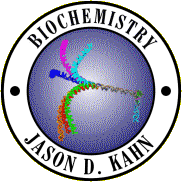Jason D. Kahn: Research Interests
Assistant ProfessorBiochemistry
Post-doc -- Yale University, 1990-1994
Ph.D. -- University of California, 1990
A.B. -- Harvard University, 1983
Jason D. Kahn: Research InterestsAssistant ProfessorBiochemistry Post-doc -- Yale University, 1990-1994 Ph.D. -- University of California, 1990 A.B. -- Harvard University, 1983 |
|
DNA structure, topology, and dynamics play important roles in DNA transactions such as transcription, recombination, and replication, but little is known about the three-dimensional organization or the dynamics of the multi-protein DNA complexes central to these processes. The group's research is directed at developing experimental techniques to approach this problem and at addressing functional implications of large-scale DNA structure. For example, many transcription factors or accessory proteins bend DNA, and the detailed architecture of the resulting complexes is currently of great interest, but the present experimental techniques generally do not give interpretable results for these systems.
The group's research will use four related approaches to these problems: Methods such as gel electrophoresis and DNA ring-closure will be used to study DNA bending in protein-DNA complexes. DNA templates with controlled structural properties will be designed to test functional effects and to generate optimal sequences for stabilizing transcription and recombination complexes. Physical methods such as crosslinking, spectroscopy, and microscopy will be applied to the structure and dynamics of such stabilized complexes. Theoretical Monte Carlo methods are used to simulate some experimental results based on models of the protein-DNA complexes.
The initial projects will include work on both prokaryotic and eukaryotic systems.
| In addition to the largely experimental work described above, I am collaborating with Rob Manning and John Maddocks of the Laboratory for Computation and Visualization in Mechanics on efficient numerical analysis, using continuum rod mechanics methods, of sequence-directed and protein-induced bends in DNA. We are interested in theoretical prediction of interesting shapes and in experimental tests of the predictions. |
 | |
|
Link to Publication List
|
Thanks to Pete Ross for providing the logo, from my computer model for DNAs of various shapes bound to TBP, soon to be modified as new data is analyzed. | |